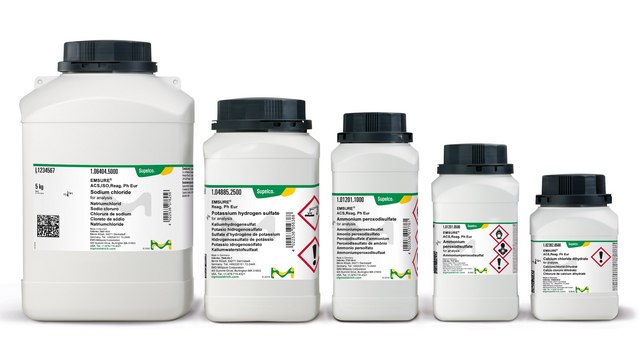208825
Copper(I) oxide
powder, ≤7 μm, 97%
Synonym(s):
Cuprous oxide
Sign Into View Organizational & Contract Pricing
All Photos(4)
About This Item
Linear Formula:
Cu2O
CAS Number:
Molecular Weight:
143.09
EC Number:
MDL number:
UNSPSC Code:
12352302
PubChem Substance ID:
NACRES:
NA.55
Assay:
97%
form:
powder
Recommended Products
Quality Level
Assay
97%
form
powder
contains
stabilizer
particle size
≤7 μm
density
6 g/mL at 25 °C (lit.)
SMILES string
[Cu]O[Cu]
InChI
1S/2Cu.O
InChI key
BERDEBHAJNAUOM-UHFFFAOYSA-N
Looking for similar products? Visit Product Comparison Guide
Related Categories
General description
Copper(I)oxide is a weak base that can be used in nucleophilic substitution, decarboxylation, cyclocondensation, and 1,1-addition reactions. It can also be used to form carbenoid intermediates from diazo compounds and radicals from arenediazonium salts.
Application
Copper(I) oxide can be used as a catalyst to synthesize:
- Ynones via solvent-free Sonogashira reaction.
- N-Heteroaryl derivatives via cross-coupling of nitrogen heterocycles with halopyridines.
Signal Word
Danger
Hazard Statements
Precautionary Statements
Hazard Classifications
Acute Tox. 4 Inhalation - Acute Tox. 4 Oral - Aquatic Acute 1 - Aquatic Chronic 1 - Eye Dam. 1
Storage Class Code
13 - Non Combustible Solids
WGK
WGK 3
Flash Point(F)
Not applicable
Flash Point(C)
Not applicable
Choose from one of the most recent versions:
Already Own This Product?
Find documentation for the products that you have recently purchased in the Document Library.
Copper (I) Oxide
Tuckmantel W
e-EROS Encyclopedia of Reagents for Organic Synthesis (2001)
Copper (I) Oxide-Mediated Cyclization of o-Haloaryl N-Tosylhydrazones: Efficient Synthesis of Indazoles.
Tang M, et al.
Advanced Synthesis & Catalysis (2016)
Dmytro S Kozak et al.
Scientific reports, 6, 21178-21178 (2016-02-18)
Electrolytic processes are widely used to synthesize different nanomaterials and it does not depend on what kind of the method has been applied (wet-chemistry, sonochemistry, plasma chemistry, electrolysis and so on). Generally, the reactions in the electrolyte are considered to
A highly efficient nano-sized Cu2O/SiO2 egg-shell catalyst for C?C coupling reactions
Kim S, et al.
Royal Society of Chemistry Advances, 8, 6200-6205 (2018)
Synthesis of copper and copper (I) oxide nanoparticles by thermal decomposition of a new precursor.
Salavati-Niasari M and Davar F.
Material Matters, 63(3), 441-443 (2009)
Our team of scientists has experience in all areas of research including Life Science, Material Science, Chemical Synthesis, Chromatography, Analytical and many others.
Contact Technical Service








